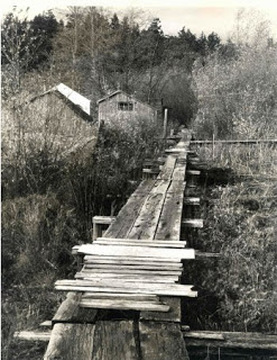I flew into Seattle, took the Greyhound bus to Mt. Vernon, and then was picked up by a dig member and taken to La Conner. The archaeology camp was located off of Dodge Valley Road at Margaret Lee’s farm up on the bluff overlooking the North Fork of the Skagit River. I remember driving up the private road to the farm, under the thick tree cover, and thinking it reminded me a lot of the wooded hills of Western Pennsylvania. I immediately felt at home. The camp was spread out over the farm with the cook tent and lab building near the farmhouse while the sleeping tents were in a back pasture. The Lees let their cattle graze under the trees. Being so “up-close-and-personal” to livestock was a first for me, but I soon got to enjoy being around them. After all, we were the intruders and had taken over their pasture. All in all, it was a magical place to spend the summer, and I felt so lucky to be able to be there to experience it.
Living on the Lee Farm allowed us to get into La Conner on a regular basis, and the town in 1974 had yet to become the tourist destination it is today. My personal recollection of the town is pretty sketchy, and I mainly remember going to the “Tav” (still going strong as the La Conner Pub & Eatery) and the 1890’s (now the lounge connected to the La Conner Seafood & Prime Rib Restaurant) to drink pitchers of beer, dance, and shoot pool. I was underage at the time (by a year) and had to be careful not to get caught by the local policeman when he was making his rounds. I also recall taking showers at the marina on a less than regular basis. We were just a bunch of archaeology students, but to the locals I’m sure we were on the same basis as those hippie Fishtown artists—tolerated but not necessarily embraced.
This was my first archaeological field experience, and it presented a great opportunity to learn. Skʷikʷikʷab, or Fishtown (site number 45SK99), was once a Lower Skagit seasonal fish camp where evidence of two houses was found. The WSU field school was directed by Dr. Astrida Blukis Onat and lasted from the end of June through August. Teams of four or five members would rotate weekly to gain a variety of experiences. We did a week of site survey, which allowed us to look for evidence of cultural materials at Bowman Beach, Similk Beach, and the “new” construction of the marina at Shelter Bay. We spent a week doing wet (hydraulic) archaeology using pumps and hoses, looking for organic cultural remains along the edge of what was once an old beach (where water once stood, the area had long since been diked and reclaimed for farming and was currently a pea field). Some basketry materials were found and dated to be about 1220 years old (plus/minus 70 years). We spent the remainder of our time doing typical “dry” archaeology using shovels, trowels and whisk brooms. It was an exceptional introduction to field archaeology and the experience acted both to whet my appetite for archaeology and to return to the Pacific Northwest the following summer to dig again.
Every day we would gather our equipment and walk down the hill to the boardwalk and travel the mile or so to the site on the north side of the ridge. It was amazing walking by the shacks/cabins that were along the boardwalk next to the river. I remember their looking really funky and cozy and great places to just watch the River roll by. They probably were drafty and cold in the winter---I’m sure they had wood stoves to keep folks toasty and warm. These little houses all had a vibrancy and the feel of a life independently and creatively lived. As a 20-year-old kid, the lifestyle was very appealing to me and proved to be a strong influence on my own life. Although I never had the opportunity to visit in them, or to meet any of their artist-residents, I took from this experience a strong desire to create and to paint.
See the Wikipedia article on the Fishtown art colony at:
https://en.wikipedia.org/wiki/Fishtown_(art_colony)
Now that I have returned to the Skagit Valley and La Conner, I have turned my interests to Japanese art. Maybe those Fishtown artists had more of an impact on me than I thought. Or maybe it’s just the Valley speaking. Regardless, I am indebted to Fishtown. Its spirit survives in me in a unique and special way.

 RSS Feed
RSS Feed